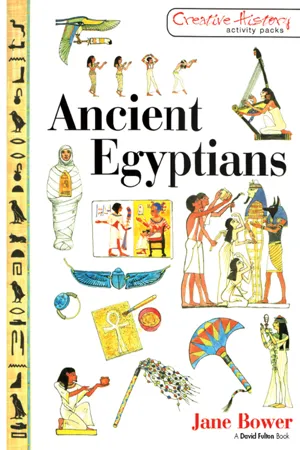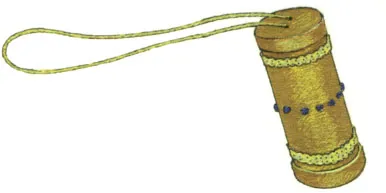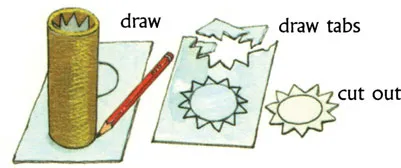![]()
PROTECTIVE SPELL, PROTECTIVE CASE
As well as amulets, spells or charms were used to ward off evil. These were written on papyrus and stored in a small case worn round the neck. The spell was to protect the wearer; the case to protect the spell.
To make a ‘papyrus’ spell you will need:
wooden board • sheet of thin white paper • teabag* • bowl of warm water • scissors • glue • piece of white cloth [the Egyptians used linen] • smooth, heavy stone [baked potato sized] • charcoal • pestle and mortar • water • wooden skewer
Papyrus was a triangular-stemmed reed which grew by the Nile. The pith inside would be split into strips for paper. To make your paper a similar colour to papyrus, dip the teabag in the warm water, squeeze, and wipe it smoothly over both sides of the sheet. When dry, cut the paper into strips 1.5 cm wide. Place a neat row of these vertically on the board as shown. Apply glue thinly and carefully to each strip and place more strips horizontally across until all the vertical ones are covered. Wipe off excess glue with a damp cloth. Place the piece of linen over the paper and roll or press the stone over it. The Egyptians would do this to weld the papyrus strips together.
Decide on the spell you are going to write. It could be asking one of the Egyptian gods to protect you, or a charm against evil:
‘Avaunt, ye dead man, who comes in the darkness, who enters stealthily, with nose behind, face turned backwards.’
[From ‘The Golden Goblet’, by E. J. McGraw.]
Grind the charcoal in the mortar. Add a little water to make ink. Using the wooden skewer as a pen, write your spell on the ‘papyrus’ and cut it out.
To make a spell container you will need:
narrow cardboard tube, or card rolled into a tube • very thin card [or slightly thick paper] • scissors • glue • gold paper • gold thread [not too thin] • decorations, e.g. gold braid, ‘jewels’ • bradawl • pencil
The Ancient Egyptians’ spell containers were small, but papyrus was very thin and could be rolled to a tiny size. You will need to make your container fit your spell.
1 Cut the tube to fit your spell. Cover the tube in gold paper, cutting tabs to fold over the two ends to give a good finish.
2 Now make two lids for the tube ends – so you need to do steps 2–6 TWICE. Draw round the end of the tube on to the card. Draw tabs round the circle. Cut the tabbed circle out. [MAKE TWO.]
3 Cut a strip of card for the side of the lid, long enough to wrap round the tube leaving an overlap. Glue it to form a ring to fit round the tube. Glue the circular tabbed top on to it. [MAKE TWO]
4 Cut another strip of card and glue it round the lid to cover the tabs. Repeat for lid 2.
5 Cover the lid in gold paper. Draw round the lid. Draw tabs as before, cut out and stick to lid. Glue tabs only, not circle, for a good finish.
6 Cover the gold tabs with a strip of gold paper. For an extra good finish, add tabs to fold underneath the rim of the lid. Repeat for lid 2.
7 Make two holes in the top lid with the bradawl. Thread a length of gold cord through, long enough to go over your head. Tie the ends under the lid.
8 Put the two lids on the tube and add any decorations.
9 Put your rolled up spell inside and wear your case round your neck.
Note
* Pyramid-shaped, of course!
![]()
SISTRUM AND SHABTI
Tomb paintings show that the Ancient Egyptians loved music and dance, and teach us what instruments they used. A sistrum was a sacred rattle, carried by women priests at special ceremonies, to worship the goddess of dance and music, Hathor.
To make a sistrum, you will need:
round-nosed pliers • strip of thick, but flexible card, 35 × 3cm [an adult may have to cut...
















